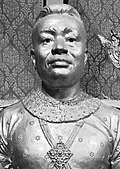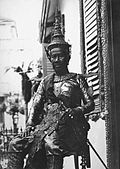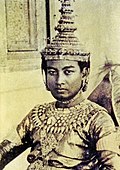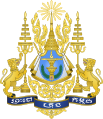Monarchy of Cambodia
This article needs additional citations for verification. (January 2017) |
| King of Cambodia | |
|---|---|
| ព្រះមហាក្សត្រនៃកម្ពុជា | |
 | |
| Incumbent | |
 | |
| Norodom Sihamoni since 29 October 2004 | |
| Details | |
| Style | His Majesty |
| First monarch | Queen Soma |
| Formation | 50 CE; 1,974–1,975 years ago |
| Abolition | 18 March 1970 – 24 September 1993 |
| Residence |
|
| Appointer | Royal Council of the Throne |
| Website | norodomsihamoni |
| This article is part of a series on the |
| Politics of Cambodia |
|---|
 |
| History of Cambodia |
|---|
| Early history |
| Post-Angkor period |
| Colonial period |
| Independence and conflict |
| Peace process |
| Modern Cambodia |
| By topic |
|
|
The monarchy of Cambodia is the constitutional monarchy of the Kingdom of Cambodia. The king of Cambodia (Khmer: ព្រះមហាក្សត្រកម្ពុជា) is the head of state and head of the ruling Royal House of Norodom. In the contemporary period, the king's power has been limited to that of a symbolic figurehead. The monarchy had been in existence since at least 50 AD except during its abolition from 1970 to 1993. Since 1993, the king of Cambodia has been an elected monarch, making Cambodia one of the few elective monarchies of the world. The king is elected for life by the Royal Council of the Throne, which consists of several senior political and religious figures. Candidates are chosen from among male descendants of King Ang Duong who are at least 30 years old, from the two royal houses of Cambodia (the House of Norodom and the House of Sisowath).
Role
[edit]Cambodia's constitution, promulgated in 1993, stipulated the king's role as a mainly ceremonial one. It declared that the king "shall reign, but not govern"[1] as well as being the "symbol of national unity and continuity".[2]
The king performs important functions of state as required by the constitution. This includes but is not limited to:
- Appointing the prime minister and the Cabinet.[3]
- Convening over the opening of the two legislative bodies, the National Assembly of Cambodia and the Senate of Cambodia.[4][5]
- Serving as the supreme commander of the Royal Cambodian Armed Forces.[6]
- Meeting with the prime minister on a semi-monthly basis in which the king is briefed on matters of state.[7]
- Signing the royal code/decree that gives effect to laws enacted by the legislature and proposals by the cabinet.[8]
- Acting as "supreme arbiter" to enable the functioning of state institutions.[9]
- Receiving credentials from ambassadors.[10]
- Possessing the power of commutation and pardon.[11]
- Presiding over the Supreme Council of the Magistracy.[12][13]
- Appointing a fixed number of members to serve on state institutions such as the Senate and the Constitutional Council.[14][15]
- Awarding of national honours.[16]
The king also fulfils other roles not explicitly mentioned in the constitution in his capacity as head of state, for example, presiding over events of national significance[17] including religious ceremonies and traditions integral to the Khmer nation,[18] supporting humanitarian and philanthropic causes,[19] and representing Cambodia abroad when undertaking official visits overseas.[20] Although there have been female rulers in the past, the 1993 constitution currently forbids women from succeeding to the throne.[21]
Ministry of the Royal Palace
[edit]The Ministry of the Royal Palace, currently overseen by Minister Kong Sam Ol in conjunction with the Supreme Privy Advisory Council, formerly headed by the King's half-brother Prince Norodom Ranariddh and now headed by former Prime Minister Hun Sen assists and advises the king accordingly in carrying out his duties as monarch.[22][23][24]
Mythological history
[edit]- Sage Kambu Swayambhuva
Ancient period (68–1431)
[edit]| Order | Monarch | Name in foreign texts | Reign |
|---|---|---|---|
| 1 | Queen Soma | Chinese Call: Liǔyè (traditional Khmer call: Neang Neak) |
68 – later 1st century |
| 2 | Kaundinya I | Chinese Call: Hùntián (traditional Khmer call: Preah Tong) |
later 1st century |
| 3 | Native name unknown | Hun Pan-huang | later 2nd century – 198 |
| 4 | Native name unknown | Hun Pan-pan | 198–201 |
| 5 | Srei Meara | Fan Shiman | 201–225 |
| 6 | Native name unknown | Fan Jinsheng | 225 |
| 7 | Native name unknown | Fan Zhan | 225–244 |
| 8 | Native name unknown | Fan Chang | 244 |
| 9 | Native name unknown | Fan Xun | 244–289 |
| Unknown rulers: 289–c.357 | |||
| 10 | Candana | Tiānzhú Zhāntán | c.357 |
| Unknown rulers: c.357–410 | |||
| 11 | Kaundinya II | Qiáochénrú | 410–434 |
| 12 | Srindravarman | Chílítuóbámó | 434–435 |
| Unknown rulers: 435–484 | |||
| 13 | Jayavarman Kaundinya | Shéyébámó | 484–514 |
| 14 | Queen Kulaprabhavati | Chinese name unknown | 514–517 |
| 15 | Rudravarman | Liútuóbámó | 514–550 |
| Unknown rulers: 550–627 | |||
| Order | Monarch | Personal name | Reign |
|---|---|---|---|
| 1 | Srutavarman | Srutavarman | 550–555 |
| 2 | Sreshthavarman | Sreshthavarman | 555–560 |
| 3 | Vīravarman | Viravarman | 560–575 |
| 4 | Queen Kambuja-raja-lakshmi | Kambujarajalakshmi | 575–580 |
| 5 | Bhavavarman I | Bhavavarman | 580–600 |
| 6 | Mahendravarman | Chet Sen | 600–616 |
| 7 | Isanavarman I | Isanavarman | 616–635 |
| 8 | Bhavavarman II | Bhavavarman | 639–657 |
| 9 | Jayavarman I | Jayavarman | 657–681 |
| 10 | Queen Jayadevi | Jayadevi | c.681–713 |
| Female successors of Upper Chenla (Land Chenla) | |||
| 11 | Queen Indrani | Indrani | c.713–760 |
| 12 | Queen Nṛpatendradevī | Nrpatendradevi | c.760–780 |
| 13 | Queen Jayendrabhā | Jayendrabha | c.780–802 |
| 14 | Queen Jyeṣṭhāryā | Jyestharya | c.802–803 |
| Male successors of Lower Chenla (Water Chenla) | |||
| 11 | Pushkaraksha | Pushkaraksha | c.713–730 |
| 12 | Shambhuvarman | Shambhuvarman | c.730–760 |
| 13 | Rajendravarman I | Rajendravarman | c.760–770 |
| 14 | Mahipativarman | Mahipativarman | c.770–780 |
| 15 | Jayavarman II | Jayavarman | c.780–802 |
Khmer Empire (802–1431)
[edit]| Order | Monarch | Personal name | Reign |
|---|---|---|---|
| 1 | Jayavarman II | Jayavarman | 802–850 |
| 2 | Jayavarman III | Jayavarthon | 850–877 |
| 3 | Indravarman I | Indravarman | 877–889 |
| 4 | Yasovarman I | Yasovarthon | 889–910 |
| 5 | Harshavarman I | Harshavarman | 910–923 |
| 6 | Ishanavarman II | Isanavarman | 923–928 |
| 7 | Jayavarman IV | Jayavarman | 928–941 |
| 8 | Harshavarman II | Harshavarman | 941–944 |
| 9 | Rajendravarman II | Rajedravarman | 944–968 |
| 10 | Jayavarman V | Jayavarman | 968–1001 |
| 11 | Udayadityavarman I | Udayadityavarman | 1001–1002 |
| 12 | Jayavirahvarman | Jayavirahvarman | 1002–1006 |
| 13 | Suryavarman I | Suryavarman | 1006–1050 |
| 14 | Udayadityavarman II | Udayadityavarman | 1050–1066 |
| 15 | Harshavarman III | Harshavarman | 1066–1080 |
| 16 | Nripatindravarman | Nripatindravarman | 1080–1113 |
| 17 | Jayavarman VI | Jayavarman | 1080–1107 |
| 18 | Dharanindravarman I | Dharanindravarman | 1107–1113 |
| 19 | Suryavarman II | Suryavarman | 1113–1150 |
| 20 | Dharanindravarman II | Dharanindravarman | 1150–1156 |
| 21 | Yasovarman II | Yasovarman | 1156–1165 |
| 22 | Tribhuvanadityavarman | Tribhuvanadityavarman | 1165–1177 |
| Cham invasion by Jaya Indravarman: 1177–1181 | |||
| 23 | Jayavarman VII | Jayavarthon | 1181–1218 |
| 24 | Indravarman II | Indrakumara | 1218–1243 |
| The first major Thai kingdom was created in Sukhothai, an area formerly ruled by Lavo in vassalage to Angkor: 1238 | |||
| 25 | Jayavarman VIII | Jayavarman | 1243–1295 |
| 26 | Indravarman III | Srei Indravama | 1295–1308 |
| 27 | Indrajayavarman | Srei Jayavama | 1308–1327 |
| 28 | Jayavarman IX | Jayavama Borommesvarah | 1327–1336 |
| 29 | Trasak Paem | Ponhea Chey | 1336–1340 |
| 30 | Nippean Bat | Ponhea Kreak | 1340–1346 |
| 31 | Sithean Reachea | Sidhanta Raja | 1346–1347 |
| 32 | Lompong Reachea | Trasak Peam | 1347–1352 |
| Uthong dynasty of Ayutthaya invasion: 1352–1357 | |||
| 33 | Basat | Bakrasat | 1356–1359 |
| 34 | Soryavong | Soryavong | 1357–1363 |
| 35 | Borom Reachea I | Barom Reamea | 1363–1373 |
| 36 | Thomma Saok | Kaeo Fa | 1373–1393 |
| Uthong dynasty of Ayutthaya invasion: 1393 (5 months) | |||
| 37 | In Reachea | Nakhonin | 1394–1421 |
| 38 | Ponhea Prek | Ponhea Prek | 1421 |
| 39 | Borom Reachea II | Ponhea Yat | 1421–1431 |
| Ayutthaya invasion and fall of Angkor: 1431 | |||
Middle period (1431–1863)
[edit]| Name | Portrait | Personal Name | Reign |
|---|---|---|---|
| Borom Reachea II បរមរាជាទី២ |
 |
Ponhea Yat ពញាយ៉ាត |
1431–1463 |
| Noreay Reameathiptei នរាយ រាមាធិបតី |
Narayanaraja នរាយណ៍រាជាទី១ទ |
1463–1469 | |
| Reachea Reameathiptei រាជា រាមាធិបតី |
Sri Raja ស្រីរាជា |
1469–1475 | |
| Srei Soriyotei ស្រីសុរិយោទ័យទី២ |
Rajadhiraja | 1472–1475 | |
| Thommo Reachea I ធម្មោ រាជា ទី១ |
Dhammarajadhiraja | 1476–1504 | |
| Srei Sukonthor ស្រីសុគន្ធធោ |
Damkhat Sukonthor | 1504–1512 |
| Name | Portrait | Personal Name | Reign | |
|---|---|---|---|---|
| Srei Chettha ស្រីជេដ្ឋា |
 |
Sdach Korn ស្ដេចកន |
1512–1521 | |
| Civil war: Srei Chettha and Chan Reachea war: 1516–1525 | ||||
| Chan Reachea ចន្ទរាជា |
Ponhea Chan ពញាចន្ទ |
1516–1566 | ||
| Barom Reachea I បរមរាជាទី១ |
Satha Mahindharaja | 1566–1576 | ||
| Satha I សត្ថាទី១ |
Barom Reachea IV បរមរាជា |
1576–1584 | ||
| Chey Chettha I ជ័យជេដ្ឋាទី១ |
Chey Chettha ជ័យជេដ្ឋា |
1584–1594 | ||
| Ayutthaya invasion and fall of Longvek: 1591–1594 | ||||
Srei Santhor era (1594–1620)
[edit]| Name | Portrait | Personal Name | Reign |
|---|---|---|---|
| Preah Ram I ព្រះរាម ទី១ |
Reamea Cheung Prey រាមាជើងព្រៃ |
1594–1596 | |
| Preah Ram II ព្រះរាម ទី២ |
Keo Ban On | 1596–1597 | |
| Paramaraja II (Barom Reachea II) បរមរាជា ទី២ |
Ponhea Ton ពញាតន់ |
1597–1599 | |
| Paramaraja III (Barom Reachea III) បរមរាជា ទី៣ |
Ponhea An ពញាអន |
1599–1600 | |
| Kaev Hua I កែវហ៊្វាទី១ |
Ponhea Nhom ពញាញោម |
1600–1603 | |
| Paramaraja IV (Barom Reachea IV) បរមរាជា ទី៤ |
Srei Soriyopor ស្រីសុរិយោពណ៌ |
1603–1618 |
| Name | Portrait | Personal Name | Reign | Relationship to predecessor |
|---|---|---|---|---|
| Chey Chettha II ជ័យជេដ្ឋាទី២ |
1618–1628 | Son | ||
| Dhammaraja II (Thommo Reachea II) ស្រីធម្មរាជាទី២ |
Ponhea To ពញាតូ |
1628–1631 | Son | |
| Ang Tong Reachea អង្គទងរាជា |
Ponhea Nou ពញានូ |
1631–1640 | Brother | |
| Padumaraja (Batom Reachea) បទុមរាជា |
Ang Non អង្គនន់ |
1640–1642 | Cousin[a] | |
| Ramadhipati (Reameathiptei I) រាមាធិបតីទី១ |
Ponhea Chan ពញាចន្ទ |
1642–1658 | Cousin | |
| Paramaraja V (Barom Reachea V) បុរមរាជា ទី៥ |
Ang So អង្គសូរ |
1658–1672 | Cousin | |
| Chey Chettha III ជ័យជេដ្ឋា ទី៣ |
1672–1673 | Nephew[b] | ||
| Kaev Hua II ព្រះកែវហ៊្វាទី២ |
Ang Chee អង្គជី |
1673–1674 | Cousin[c] | |
| Batom Reachea III បទុមរាជាទី៣ |
Ang Nan | 1674 | [d] | |
| Chey Chettha IV ជ័យជេដ្ឋា ទី៤ |
Ang Sor | 1675–1695, 1696–1699, 1700–1702 and 1703–1706 | [e] | |
| Queen Tey ទៃ |
1687 | Mother[27] | ||
| Outey I ឧទ័យទី១ |
Ang Yong អង្គយ៉ង |
1695–1696 | Cousin once removed[f] | |
| Parama Ramadhipati (Barom Reameathiptei) បរម រាមាធិបតី |
Ang Em | 1699–1700 and 1710–1722 | [g] | |
| Dhammaraja III (Thommo Reachea III) សេដ្ឋា ទី២ |
Ang Tham | 1702–1703, 1706–1709 and 1736–1747 | [h] | |
| Satha II សេដ្ឋា ទី២ |
Ang Chey អង្គជ័យ |
1722–1736 and 1749 | [i] | |
| Dhammaraja IV (Thommo Reachea IV) ស្រីធម្មរាជា |
Ang Em អង្គឯម |
1747 | [j] | |
| Ramadhipati III (Reameathiptei III) រាមាធិបតីទី៣ |
Ang Tong អង្គទង |
1748–1749, 1755–1758 | Brother-in-law | |
| Chey Chettha V ជ័យជេដ្ឋា ទី៥ |
Ang Snguon អង្គស្ងួន |
1749–1755 | Brother-in-law | |
| Udayaraja II (Outey Reachea II) ឧទ័យរាជា ទី២ |
Ang Ton អង្គតន់ |
1758–1775 | Cousin twice removed[k] | |
| Ream Reachea ព្រះរាមរាជា |
Ang Non II អង្គនន់ទី ២ |
1775–1779 | Cousin once removed[l] | |
| Narayanaraja III (Neareay Reachea III) នារាយណ៍រាជាទី ៣ ។ |
Ang Eng អង្គអេង |
1779–1782, 1794–1796 | Cousin twice removed[m] | |
| Regency, Outey Reachea III being a minor: 1796–1806 | ||||
| Udayaraja III (Outey Reachea III) ឧទ័យរាជា ទី៣ |
Ang Chan II អង្គចន្ទ |
1806–1834 | Son | |
| Queen Ang Mey អង្គម៉ី |
 |
Ksat Trey | 1835–1840, 1844–1846 | Daughter |
| Hariraksa Rama Issaradhipati (Harireak Reamea Issarathiptei) ហរិរក្សរាមាឥស្សរាធិបតី |
 |
Ang Duong អង្គដួង |
1848–1860 | Uncle |
| Norodom Prohmbarirak នរោត្ដម ព្រហ្មបរិរក្ស |
 |
Ang Voddey អង្គវតី |
19 October 1860 – 11 August 1863 |
Son |
Modern period (1863–present)
[edit]French protectorate of Cambodia (1863–1953)
[edit]| Name | Portrait | House | Birth | Death | Relationship to predecessor |
|---|---|---|---|---|---|
| Norodom Prohmbarirak នរោត្ដម ព្រហ្មបរិរក្ស 11 August 1863 – 24 April 1904 (40 years, 257 days) |
 |
Norodom | 3 February 1834 Angkor Borei |
24 April 1904 Phnom Penh Aged: 70 years, 81 days |
Son |
| Sisowath Chamchakrapong ស៊ីសុវត្ថិ ចមចក្រពង្ស 27 April 1904 – 9 August 1927 (23 years, 104 days) |
 |
Sisowath | 7 September 1840 Mongkol Borey |
9 August 1927 Phnom Penh Aged: 86 years, 336 days |
Half-brother |
| Sisowath Monivong ស៊ីសុវត្ថិ មុនីវង្ស 9 August 1927 – 23 April 1941 (13 years, 257 days) |
 |
Sisowath | 27 December 1875 Phnom Penh |
23 April 1941 Kampot Aged: 65 years, 117 days |
Son |
| Norodom Sihanouk[28] នរោត្តម សីហនុ 24 April 1941 – 2 March 1955 (13 years, 312 days) |
 |
Norodom | 31 October 1922 Phnom Penh |
15 October 2012 Beijing Aged: 89 years, 350 days |
Maternal grandson |
First Kingdom of Cambodia (1953–1970)
[edit]| Name | Portrait | House | Birth | Death | Relationship to predecessor |
|---|---|---|---|---|---|
| Norodom Suramarit នរោត្តម សុរាម្រិត 3 March 1955 – 3 April 1960 (5 years, 31 days) |
 |
Norodom | 6 March 1896 Phnom Penh |
3 April 1960 Phnom Penh Aged: 64 years, 28 days |
Father |
| Queen Sisowath Kossamak ស៊ីសុវត្ថិ កុសុមៈ 20 June 1960 – 9 October 1970 (10 years, 111 days)[n] |
 |
Sisowath (by birth) Norodom (by marriage) |
9 April 1904 Phnom Penh |
27 April 1975 Beijing Aged: 71 years, 18 days |
Consort |
Second Kingdom of Cambodia (1993–present)
[edit]| Name | Portrait | House | Birth | Death | Relationship to predecessor |
|---|---|---|---|---|---|
| Norodom Sihanouk នរោត្តម សីហនុ 24 September 1993 – 7 October 2004 (11 years, 13 days) |
 |
Norodom | 31 October 1922 Phnom Penh |
15 October 2012 Beijing Aged: 89 years, 350 days |
Son |
| Norodom Sihamoni នរោត្តម សីហមុនី 14 October 2004 – present (20 years, 96 days) |
 |
Norodom | 14 May 1953 Phnom Penh |
Living Age: 71 years, 249 days |
Son |
Royal symbols
[edit]-
Royal Arms of Cambodia (1953–1970), restored 1993
-
Royal Arms of Cambodia (1864–1953), lesser arms (1953–1970)
-
Royal Standard of the King of Cambodia (until 1970)
-
Royal Standard of The King of Cambodia (since 1993)
See also
[edit]- Monarchs' family tree
- List of heads of state of Cambodia
- Prime Minister of Cambodia
- Devaraja
- Abolition of monarchy
Notes
[edit]- ^ Son of Outey, which was the brother to Chey Chettha II
- ^ Son of Batom Reachea, which was a brother to Barom Reachea V (both sons of Outey)
- ^ Son of Barom Reachea V
- ^ Grandson of Outey
- ^ Son of Barom Reachea V
- ^ Son of Preah Keo II, who was a cousin to Chey Chettha IV
- ^ Son of Batom Reachea III
- ^ Son of Chey Chettha IV
- ^ Son of Barom Reameathiptei
- ^ Son of Thommo Reachea III
- ^ Grandson of Ang Tong
- ^ Son of Chey Chettha V
- ^ Son Outey II
- ^ Queen Sisowath Kossamak was not an official monarch, but a "symbol, incarnation, and representative" of the dynasty after the death of her husband, King Norodom Suramarit. Norodom Sihanouk appointed himself chief of state whose powers equal that of a traditional monarch.[29][30]
References
[edit]- ^ The Constitution of the Kingdom of Cambodia, Chapter II, Article 7.
- ^ The Constitution of the Kingdom of Cambodia, Chapter II, Article 8.
- ^ The Constitution of the Kingdom of Cambodia, Chapter X, Article 119.
- ^ The Constitution of the Kingdom of Cambodia, Chapter VII, Article 82.
- ^ The Constitution of the Kingdom of Cambodia, Chapter VIII, Article 106.
- ^ The Constitution of the Kingdom of Cambodia, Chapter II, Article 23.
- ^ The Constitution of the Kingdom of Cambodia, Chapter II, Article 20.
- ^ The Constitution of the Kingdom of Cambodia, Chapter II, Articles 26 and 28.
- ^ The Constitution of the Kingdom of Cambodia, Chapter II, Article 9.
- ^ The Constitution of the Kingdom of Cambodia, Chapter II, Article 25.
- ^ The Constitution of the Kingdom of Cambodia, Chapter II, Article 27.
- ^ The Constitution of the Kingdom of Cambodia, Chapter II, Article 21.
- ^ The Constitution of the Kingdom of Cambodia, Chapter XI, Article 134.
- ^ The Constitution of the Kingdom of Cambodia, Chapter VIII, Article 100.
- ^ The Constitution of the Kingdom of Cambodia, Chapter XII, Article 137.
- ^ The Constitution of the Kingdom of Cambodia, Chapter II, Article 29.
- ^ "Cambodian king,..."
- ^ "Cambodia marks..."
- ^ "$1 million royal gift..."
- ^ ""President Xi meets Cambodian king in Beijing" in GB Times". Archived from the original on 12 May 2019. Retrieved 25 October 2018.
- ^ Jeldres, Julio A. (2 April 1999). "Cambodia's Monarchy: The search for the successor". The Phnom Penh Post. Archived from the original on 2 August 2020. Retrieved 21 June 2020.
- ^ "Cambodian Prince Ranariddh's body arrives home from France". The Star. 5 December 2021. Retrieved 28 July 2023.
- ^ "Reign of the quiet king". The Phnom Penh Post. 29 October 2014. Retrieved 8 September 2021.
- ^ "Hun Sen made Privy Council President". Khmer Times. 23 August 2023. Retrieved 26 August 2023.
- ^ a b Sharan, Mahesh Kumar (2003). Studies In Sanskrit Inscriptions Of Ancient Cambodia. Abhinav Publications. pp. 27–28, 33–34. ISBN 978-81-7017-006-8.
- ^ a b Jacobsen, Trudy (2008). Lost Goddesses: The Denial of Female Power in Cambodian History. NIAS Press. pp. 22–23, 27–30. ISBN 978-87-7694-001-0.
- ^ Jacobsen, Trudy (2008). Lost Goddesses: The Denial of Female Power in Cambodian History. NIAS Press. p. 87. ISBN 978-87-7694-001-0.
Jai Jettha III, who ruled five or six times between 1677 and 1702, abdicated in 1687 in favour of his mother Queen Tey. She remained there for a matter of months before returning the throne to her son.
- ^ "Constitution of Cambodia 1947" (PDF). 6 May 1947. Archived (PDF) from the original on 27 July 2021. Retrieved 27 July 2021.
- ^ "Cambodian Queen is Dead in Peking". The New York Times. 28 April 1975. Archived from the original on 20 August 2020. Retrieved 23 June 2020.
- ^ Chandler, David (4 May 2018). A History of Cambodia (4th ed.). Routledge. p. 235. ISBN 978-0-429-96406-0.
In 1960 Sihanouk's father, King Suramarit, died. After a series of maneuvers, Sihanouk had himself named Cambodia's chief of state with his mother, Queen Kossamak, continuing to serve as a monarch for ceremonial purposes.
External links
[edit]- "$1 million royal gift for Kantha Bopha" in Khmer Times Archived 12 September 2019 at the Wayback Machine
- "Cambodia marks beginning of farming season with royal ploughing ceremony" in Xinhuanet
- "Cambodian king, PM wrap up annual Water Festival" in Xinhuanet
- "The Constitution of the Kingdom of Cambodia" (PDF). World Intellectual Property Organization. Archived (PDF) from the original on 13 February 2020. Retrieved 16 July 2019.
- "President Xi meets Cambodian king in Beijing" in GB Times Archived 12 May 2019 at the Wayback Machine




